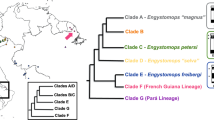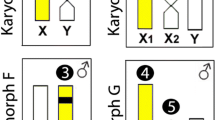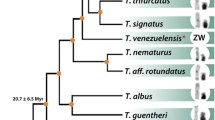Abstract
Cross-species chromosome painting was used to investigate genome rearrangements between tammar wallaby Macropus eugenii (2n = 16) and the swamp wallaby Wallabia bicolor (2n = 10♀/11♂), which diverged about 6 million years ago. The swamp wallaby has an XX female:XY1Y2 male sex chromosome system thought to have resulted from a fusion between an autosome and the small original X, not involving the Y. Thus, the small Y1 should represent the original Y and the large Y2 the original autosome. DNA paints were prepared from flow-sorted and micro-dissected chromosomes from the tammar wallaby. Painting swamp wallaby spreads with each tammar chromosome-specific probe gave extremely strong and clear signals in single-, two-, and three-color FISH. These showed that two tammar wallaby autosomes are represented unchanged in the swamp wallaby, two are represented by different centric fusions, and one by a tandem fusion to make the very long arms of swamp wallaby Chromosome (Chr) 1. The large swamp wallaby X comprises the tammar X as its short arm, and a tandemly fused 7 and 2 as the long arm. The acrocentric swamp wallaby Y2 is a 2/7 fusion, homologous with the long arm of the X. The small swamp wallaby Y1 is confirmed as the original Y by its painting with the tammar Y. However, the presence of sequences shared between the microdissected tammar Xp and Y on the swamp wallaby Y2 implies that the formation of the compound sex chromosomes involved addition of autosome(s) to both the original X and Y. We propose that this involved fusion with an ancient pseudoautosomal region followed by fission proximal to this shared region.
Similar content being viewed by others

References
Ferguson-Smith MA (1995) Gene order by FISH and FACS. In Molecular Biology and Biotechnology. A Comprehensive Desk Reference, R.A. Meyers (ed) (VCH Publishers, Inc.), pp 354–359
Frönicke L, Chowdhary BP, Scherthan H, Gustavsson I (1996) A comparative map of the porcine and human genomes demonstrates ZOO-FISH and gene mapping-based chromosomal homologies. Mamm Genome 7, 285–290
Graves JAM, Watson JM (1991) Mammalian sex chromosomes: evolution of organization and function. Chromosoma 101, 63–68
Graves JAM, Cooper DW, McKenzie LM, Hope RM, Watson JM (1993) Genetic maps of marsupial and monotreme mammals. In Genetic Maps. Locus Maps of Complex Genomes, S.J. O’Brien (ed) (Cold Spring Harbor, N.Y.: Cold Spring Harbor Laboratories Press), pp. 4.282–4.289
Hayman DL, Martin PG (1974) Mammalia I: Monotremata and Marsupialia. In Animal Cyotgenetics, 4 Chordata, B. John (ed) (Berlin, Stuttgart: Gebrüder Borntraeger), pp 000–000
Köhler U, Arnold N, Wienberg J, Tofanelli S, Stanyon R (1995a) Genomic reorganization and disrupted chromosomal synteny in the siamang (Hy-lobates syndactylus) revealed by fluorescence in situ hybridization. Am J Phys Anthropol 97, 37–47
Köhler U, Bigoni F, Wienberg J, Stanyon R (1995b) Genomic reorganization in the concolor gibbon (Hylobates concolor) revealed by chromosome painting. Genomics 30, 287–292
Lichter P, Cremer T, Borden J, Manuelidis L, Ward DC (1988) Delineation of individual human chromosomes in metaphase and interphase cells by in situ suppression hybridization using recombinant DNA libraries. Hum Genet 80, 224–234
Meltzer PS, Guan XY, Burgess A, Trent JM (1992) Rapid generation of region specific probes by chromosome microdissection and their application. Nature Genet 1, 24–28
Nash WG, O'Brien SJ (1982) Conserved regions of homologous G-banded chromosomes between orders in mammalian evolution: carnivores and primates. Proc Natl Acad Sci USA 79, 6631–6635
O’Brien SJ, Seuánez HN, Womack JE (1988) Mammalian genome organization: an evolutionary view. Annu Rev Genet 22, 323–351
Raudsepp T, Frönicke L, Scherthan H, Gustavsson I, Chowdhary BP (1996). Zoo-FISH delineates conserved chromosomal segments in horse and man. Chromosome Res 4, 218–225
Rettenberger G, Klett C, Zechner U, Bruch J, Just W, Vogel W, Hameister H (1995a) ZOO-FISH analysis: cat and human karyotypes closely resemble the putative ancestral mammalian karyotype. Chromosome Res 3, 479–486
Rettenberger G, Klett C, Zechner U, Kunz J, Vogel W, Hameister H (1995b) Visualization of the conversation of synteny between humans and pigs by heterologous chromosomal painting. Genomics 26, 372–378
Rofe RH (1978) G-banded chromosomes and the evolution of Macropodidae. Aust Mammal 2, 53–63
Scherthan H, Cremer T, Arnason U, Weier HU, Lima-de-Faria A, Frönicke L (1994) Comparative chromosome painting discloses homologous segments in distantly related mammals. Nature Genet 6, 342–347
Solinas-Toldo S, Lengauer C, Fries R (1995) Comparative genome map of human and cattle. Genomics 27, 489–496
Telenius H, Pelmear A, Tunnacliffe A, Carter NP, Behmel A, Ferguson-Smith MA, Nordenskjold M, Pfragner R, Ponder B (1992) Cytogenetic analysis by chromosome painting using DOP-PCR amplified flowsorted chromosomes. Genes Chromosomes Cancer 4, 257–263
Toder R, Zeitler S, Goodfellow PN, Schempp W (1993) Comparative mapping of SRY in the great apes. Chromosome Res 1, 117–120
Toder R, Rappold GA, Schiebel K, Schempp W (1995) ANT3 and STS are autosomal in prosimian lemurs; implications for the evolution of the pseudoautosomal region. Hum Genet 95, 22–28
Toder R, Wilcox SA, Smithwick M, Graves JAM (1996) The human-mouse imprinted genes IGF2, H19, SNRPN and ZNF127 map to two conserved autosomal clusters in a marsupial. Chromosome Res 4, 295–300
Toder R, Wienberg J, Voullaire L, Maccarone P, Graves JAM (1997) Shared DNA sequences between the X and Y Chromosome in the tammar Wallaby-evidence for independent additions to eutherian and marsupial sex chromosomes. Chromosoma (in press)
Wienberg J, Stanyon R (1995) Chromosome painting in mammals as an approach to comparative genomics. Curr Opin Genet Dev 5, 792–797
Yunis JJ, Prakash O (1982) The origin of man: a chromosomal pictorial legacy. Science 215, 1525–1530
Author information
Authors and Affiliations
Rights and permissions
About this article
Cite this article
Toder, R., O’Neill, R.J.W., Wienberg, J. et al. Comparative chromosome painting between two marsupials: origins of an XX/XY1Y2 sex chromosome system. Mammalian Genome 8, 418–422 (1997). https://doi.org/10.1007/s003359900459
Received:
Accepted:
Issue Date:
DOI: https://doi.org/10.1007/s003359900459



